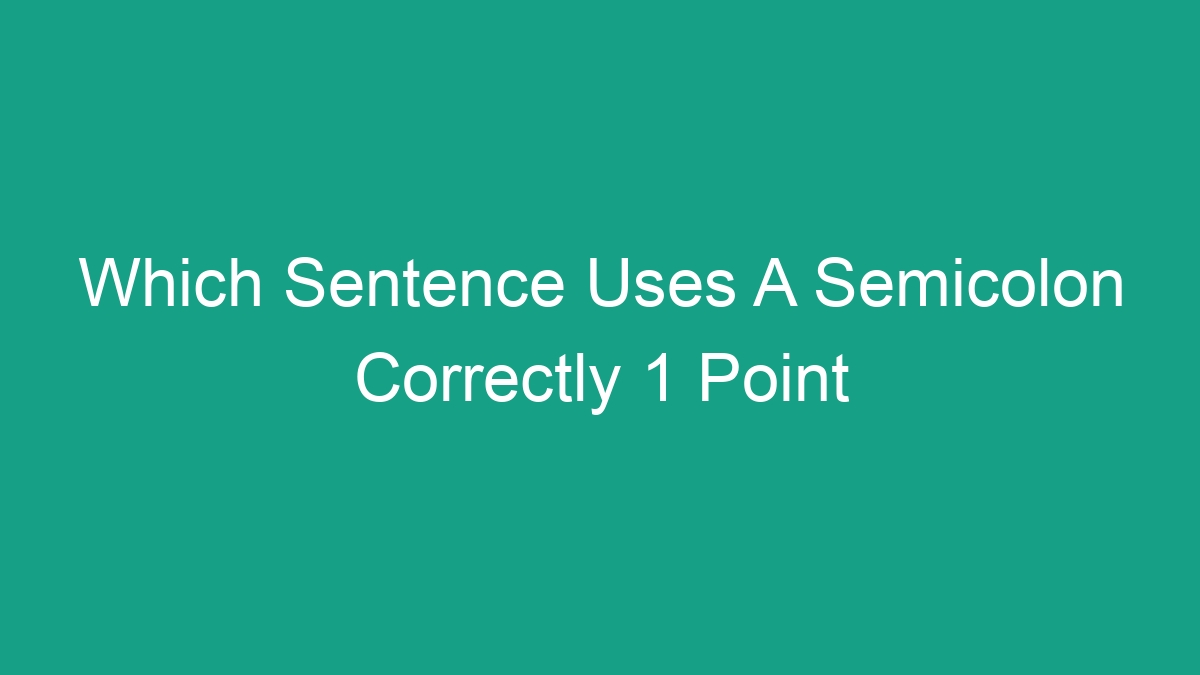
Semicolons can be a tricky punctuation mark to master, but when used correctly, they can add clarity and sophistication to your writing. In this comprehensive guide, we will discuss how to use semicolons correctly, provide examples, and address common misconceptions. By the end of this article, you will have a clear understanding of when and how to use semicolons in your writing.
Understanding the Purpose of a Semicolon
Before we delve into the correct usage of semicolons, it’s important to understand their purpose. Semicolons are used to connect two independent clauses that are closely related in content. In essence, a semicolon serves as a stronger pause than a comma but not as final as a period.
How to Use a Semicolon
There are a few key rules to keep in mind when using a semicolon:
- Connecting Independent Clauses: Use a semicolon to join two independent clauses that are closely related in content.
- Separating Items in a Series: Use a semicolon to separate items in a series if the items themselves contain commas.
- Avoiding Comma Splices: Use a semicolon to avoid comma splices, which occur when two independent clauses are incorrectly joined by a comma without a coordinating conjunction.
Examples of Correct Semicolon Usage
Let’s take a look at some examples of correct semicolon usage:
- Connecting Independent Clauses: “I have a meeting at 3:00 p.m.; however, I can reschedule if necessary.”
- Separating Items in a Series: “On my trip, I visited Paris, France; Rome, Italy; and Barcelona, Spain.”
- Avoiding Comma Splices: “The deadline is approaching; we need to finalize our proposal soon.”
Common Misconceptions About Semicolons
There are a few common misconceptions about semicolons that often lead to confusion. Let’s address these misconceptions and provide clarity on their usage.
Semicolons vs. Colons
One common misconception is the confusion between semicolons and colons. While both punctuation marks serve distinct purposes, their usage can be mistaken. Semicolons are used to connect two independent clauses, while colons are used to introduce a list or to provide further explanation or emphasis.
Overusing Semicolons
Another misconception is the tendency to overuse semicolons. While semicolons can be effective in certain contexts, overusing them can make your writing appear cluttered and disjointed. It’s important to use semicolons judiciously and only when they serve a clear purpose in connecting related independent clauses.
Confusion with Commas and Semicolons
Some writers may struggle with when to use a comma versus a semicolon. While both punctuation marks indicate a pause, the key distinction lies in their ability to connect independent clauses. A comma is used for lighter pauses and to separate items in a list, while a semicolon indicates a stronger connection between independent clauses.
When Not to Use a Semicolon
It’s equally important to understand when not to use a semicolon to avoid common mistakes in writing. Here are some instances where a semicolon should not be used:
- Before a Conjunction: Do not use a semicolon before a coordinating conjunction such as “and,” “but,” or “or.” Use a comma and a coordinating conjunction to join independent clauses.
- After a Subordinating Conjunction: Do not use a semicolon after a subordinating conjunction such as “because,” “since,” or “although.” These conjunctions introduce dependent clauses and should be followed by a comma if necessary.
Conclusion
Mastering the use of semicolons can elevate your writing and add nuance to your prose. By understanding the purpose of a semicolon, knowing when to use it, and being aware of common misconceptions, you can confidently incorporate semicolons into your writing. Remember to use semicolons judiciously, and always ensure that they serve a clear purpose in connecting related independent clauses.
FAQs
How do I know when to use a semicolon?
Use a semicolon to connect two independent clauses that are closely related in content. Avoid using a semicolon before a coordinating conjunction or after a subordinating conjunction.
Can a semicolon replace a comma?
While a semicolon can serve a similar function to a comma in separating items in a series, it is typically used to connect independent clauses rather than to simply indicate a pause.
What are some common mistakes to avoid when using semicolons?
Avoid overusing semicolons, using them before coordinating conjunctions, and using them after subordinating conjunctions. It’s important to use semicolons judiciously and only when they serve a clear purpose in connecting related independent clauses.



